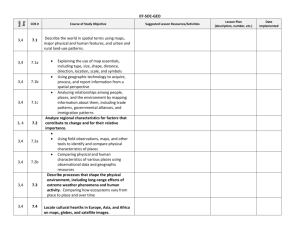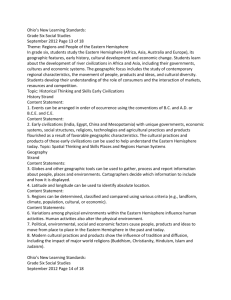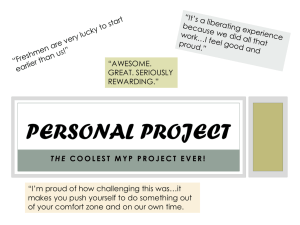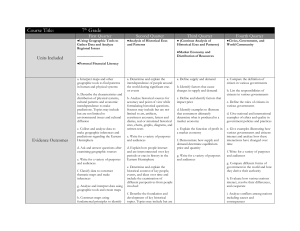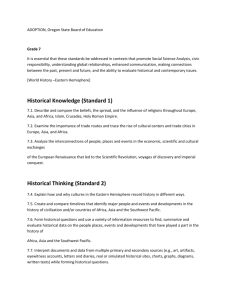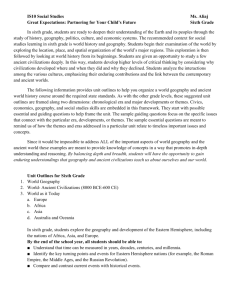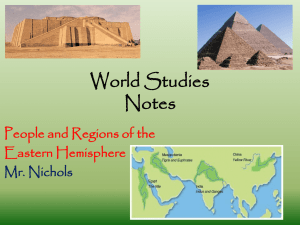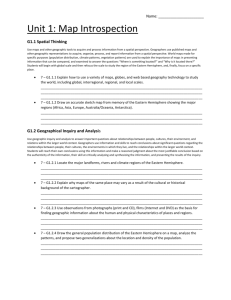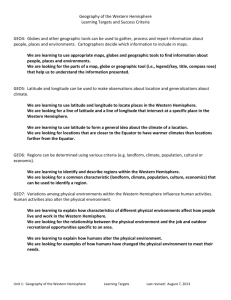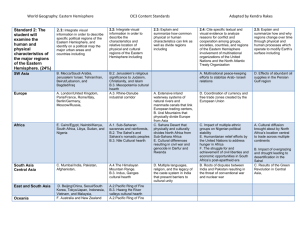MYP unit planner
advertisement
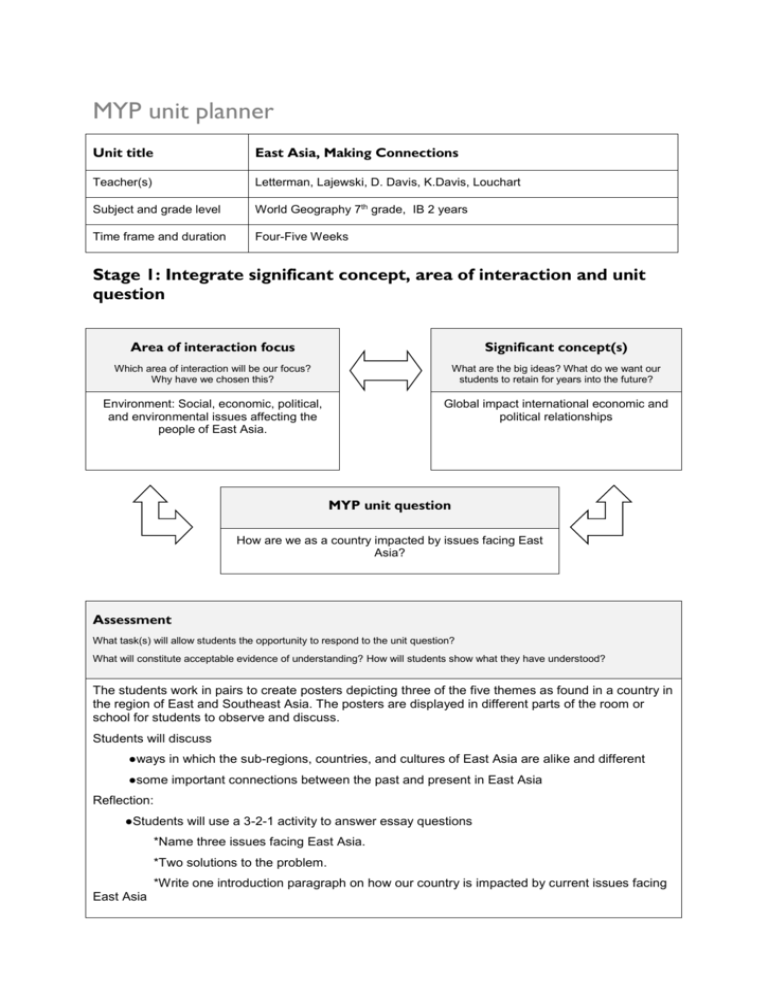
MYP unit planner Unit title East Asia, Making Connections Teacher(s) Letterman, Lajewski, D. Davis, K.Davis, Louchart Subject and grade level World Geography 7th grade, IB 2 years Time frame and duration Four-Five Weeks Stage 1: Integrate significant concept, area of interaction and unit question Area of interaction focus Significant concept(s) Which area of interaction will be our focus? Why have we chosen this? What are the big ideas? What do we want our students to retain for years into the future? Environment: Social, economic, political, and environmental issues affecting the people of East Asia. Global impact international economic and political relationships MYP unit question How are we as a country impacted by issues facing East Asia? Assessment What task(s) will allow students the opportunity to respond to the unit question? What will constitute acceptable evidence of understanding? How will students show what they have understood? The students work in pairs to create posters depicting three of the five themes as found in a country in the region of East and Southeast Asia. The posters are displayed in different parts of the room or school for students to observe and discuss. Students will discuss ●ways in which the sub-regions, countries, and cultures of East Asia are alike and different ●some important connections between the past and present in East Asia Reflection: ●Students will use a 3-2-1 activity to answer essay questions *Name three issues facing East Asia. *Two solutions to the problem. *Write one introduction paragraph on how our country is impacted by current issues facing East Asia Which specific MYP objectives will be addressed during this unit? Knowledge and Understanding: Using the Five Themes of Geography, students will explore different countries of East Asia and display their knowledge of a given country Investigation: Formulating question and researching facts about an assigned East Asian country Thinking Critically: Analyzing issues that are currently defined in East Asia Which MYP assessment criteria will be used? Criterion A: Knowledge and Understanding Criterion B: Investigation Stage 2: Backward planning: from the assessment to the learning activities through inquiry Content What knowledge and/or skills (from the course overview) are going to be used to enable the student to respond to the unit question? What (if any) state, provincial, district, or local standards/skills are to be addressed? How can they be unpacked to develop the significant concept(s) for stage 1? Knowledge- geography and overview of the history of East Asia Describe cultural characteristics of various countries and regions of East Asia Skills- interpret maps related to political and economic issues Compare and contrast countries and regions of East Asia in terms of political structures, social, environmental, and economic issues. Making connections from East Asia to the World. Content Expectations 7 – H1.4.2: Describe and use themes of history to study patterns of change and continuity. See also 6 – H1.4.2. 7 – G1.1.1: Explain and use a variety of maps, globes, and web based geography technology to study the world, including global, interregional, regional, and local scales. 7 – G1.2.4: Draw the general population distribution of the Eastern Hemisphere on a map, analyze the patterns, and propose two generalizations about the location and density of the population. 7 – G1.2.6: Apply the skills of geographic inquiry (asking geographic questions, acquiring geographic information, organizing geographic information, analyzing geographic information, and answering geographic questions) to analyze a problem or issue of importance to a region. See also 6 – G1.2.6. 7 –G1.3.2: Explain the locations and distributions of physical and human characteristics of Earth by using knowledge of spatial patterns. 7 – G2.1.1: Describe the landform features and the climate of the region (within the Western or Eastern Hemispheres) under study. 7 – G4.1.1: Identify and explain examples of cultural diffusion within the Eastern Hemisphere (e.g., the spread of sports, music, architecture, television, Internet, Bantu languages in Africa, Islam in Western Europe). 7 – G4.3.1 Identify places in the Eastern Hemisphere that have been modified to be suitable for settlement by describing the modifications that were necessary (e.g., Nile River irrigation, reclamation of land along the North Sea, planting trees in areas that have become desertified in Africa). 7 – G4.3.2: Describe patterns of settlement by using historical and modern maps (e.g., the location of the world’s mega cities, other cities located near coasts and navigable rivers, regions under environmental stress such as the Sahel). 7 – G4.4.1: Identify factors that contribute to conflict and cooperation between and among cultural groups (control/use of natural resources, power, wealth, and cultural diversity). 7 – G5.1.1: Describe the environmental effects of human action on the atmosphere (air), biosphere (people, animals, and plants), lithosphere (soil), and hydrosphere (water) (e.g., changes in the tropical forest environments in Brazil, Peru, and Costa Rica). See also 6 – G5.1.1. 7 – G5.1.3: Identify the ways in which human-induced changes in the physical environment in one place can cause changes in other places (e.g., cutting forests in one region may result in river basin flooding elsewhere as has happened historically in China; building dams floods land upstream and permits irrigation downstream as in Southern Africa, the Aswan Dam flooded the upper Nile Valley and permitted irrigation downstream). 7 – C1.1.1: Explain how the purposes served by government affect relationships between the individual, government, and society as a whole and the differences that occur in monarchies, theocracies, dictatorships, and representative governments. 7 – C3.6.1: Define the characteristics of a nation-state (a specific territory, clearly defined boundaries, citizens, and jurisdiction over people who reside there, laws, and government) and how Eastern Hemisphere nations interact. 7 – C4.3.2: Explain the challenges to governments and the cooperation needed to address international issues in the Eastern Hemisphere (e.g., migration and human rights). 7 – E2.3.1: Explain how national governments make decisions that impact both that country and other countries that use its resources (e.g., sanctions and tariffs enacted by a national government to prevent imports, most favored trade agreements, the impact China is having on the global economy and the U.S. economy in particular). 7 – E3.1.1: Explain the importance of trade (imports and exports) on national economies in the Eastern Hemisphere (e.g., natural gas in North Africa, petroleum Africa, mineral resources in Asia). 7 – E3.1.4: Explain how communications innovations have affected economic interactions and where and how people work (e.g., internet home offices, international work teams, international companies). See also 6 – E3.1.4. 7 – E3.3.1: Explain and compare how economic systems (traditional, command, and market) answer four basic questions: What should be produced? How will it be produced? How will it be distributed? Who will receive the benefits of production? (e.g., market economies in Africa, Europe; command economy in North Korea; and the transition to market economies in Vietnam and China). Approaches to learning How will this unit contribute to the overall development of subject-specific and general approaches to learning skills? Inquiry- asking questions and researching an East Asian country Knowledgeable-they will examine health, environmental, social and political issues that impact many East Asian countries Thinking – creating a poster; comparing and contrasting East Asian countries. Communication-understand and share ideas with classmates in a creative manner Open minded- appreciation for cultures and traditions, different from your own Risk takers- creating a poster with confidence on a subject they are not familiar with and utilizing technology Reflective – on how issues of East Asia impact them and their world. Learning experiences How will students know what is expected of them? Will they see examples, rubrics, templates? How will students acquire the knowledge and practise the skills required? How will they practise applying these? Do the students have enough prior knowledge? How will we know? 1. They will be given a rubric with descriptions of what needs to go on the poster. 2. Using student resources provided by the teacher (websites: CIA World Fact Book, un.org, Culturegrams), students will research and explore their assigned country. During a class discussion, they will compare and contrast: ●ways in which the sub-regions, countries, and cultures of East Asia are alike and different ●some important connections between the past and present in East Asia Teaching strategies How will we use formative assessment to give students feedback during the unit? What different teaching methodologies will we employ? How are we differentiating teaching and learning for all? How have we made provision for those learning in a language other than their mother tongue? How have we considered those with special educational needs? Teacher will model expectations for posters by creating an example. Teacher will use LCD projector to show students how to utilize websites for research. Students will be required to compare and contrast different countries of East Asia. Power Points with maps and charts of East Asia will be used to help students learn about issues facing East Asia and be required to answer related analytical questions. In 3-2-1 question format, students will be required to write a reflective essay. Differentiated Instruction: Supplemental materials for students with reading difficulties at lower levels. Specific lists of things to include on the poster. Use students’ IEPs to modify plans Resources What resources are available to us? How will our classroom environment, local environment and/or the community be used to facilitate students’ experiences during the unit? World Geography Books, Internet websites (un.org, CIA World Factbook, Culturegrams, students’ work from prior years, travel brochures, Word Publisher Students are encouraged to use people from the community who may have travelled to these countries as well as family. Ongoing reflections and evaluation In keeping an ongoing record, consider the following questions. There are further stimulus questions at the end of the “Planning for teaching and learning” section of MYP: From principles into practice. Students and teachers What did we find compelling? Were our disciplinary knowledge/skills challenged in any way? What inquiries arose during the learning? What, if any, extension activities arose? How did we reflect—both on the unit and on our own learning? Which attributes of the learner profile were encouraged through this unit? What opportunities were there for student-initiated action? Possible connections How successful was the collaboration with other teachers within my subject group and from other subject groups? What interdisciplinary understandings were or could be forged through collaboration with other subjects? Assessment Were students able to demonstrate their learning? How did the assessment tasks allow students to demonstrate the learning objectives identified for this unit? How did I make sure students were invited to achieve at all levels of the criteria descriptors? Are we prepared for the next stage? Data collection How did we decide on the data to collect? Was it useful? Figure 12 MYP unit planner


